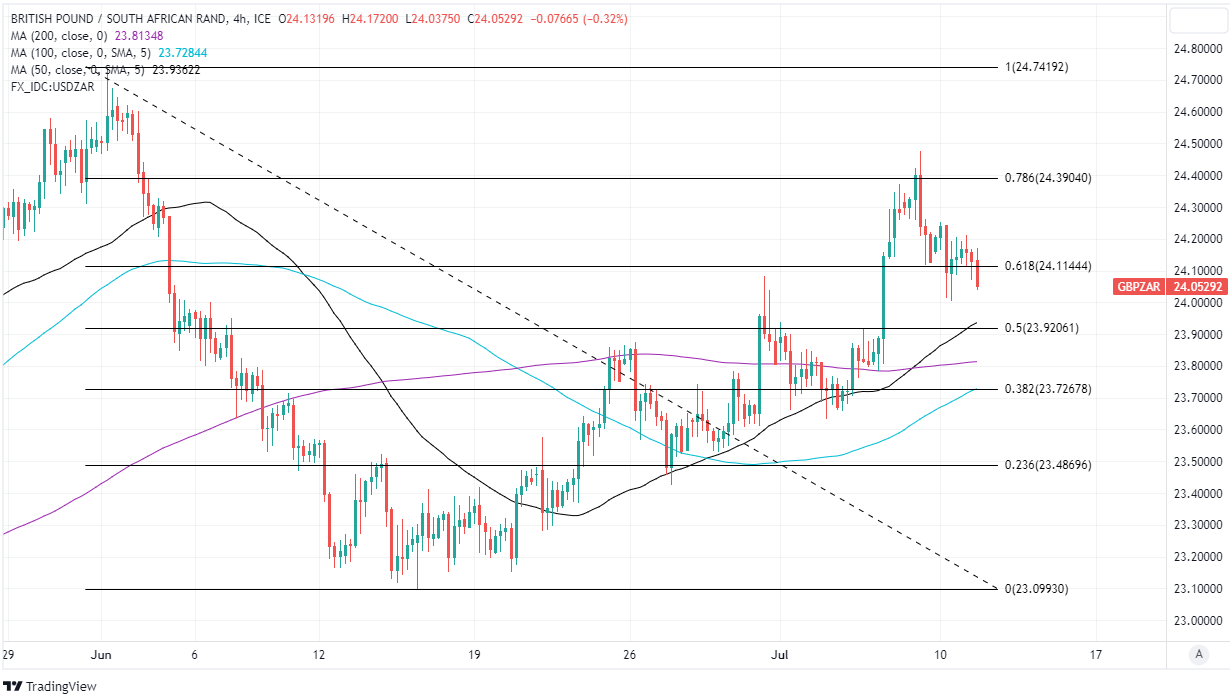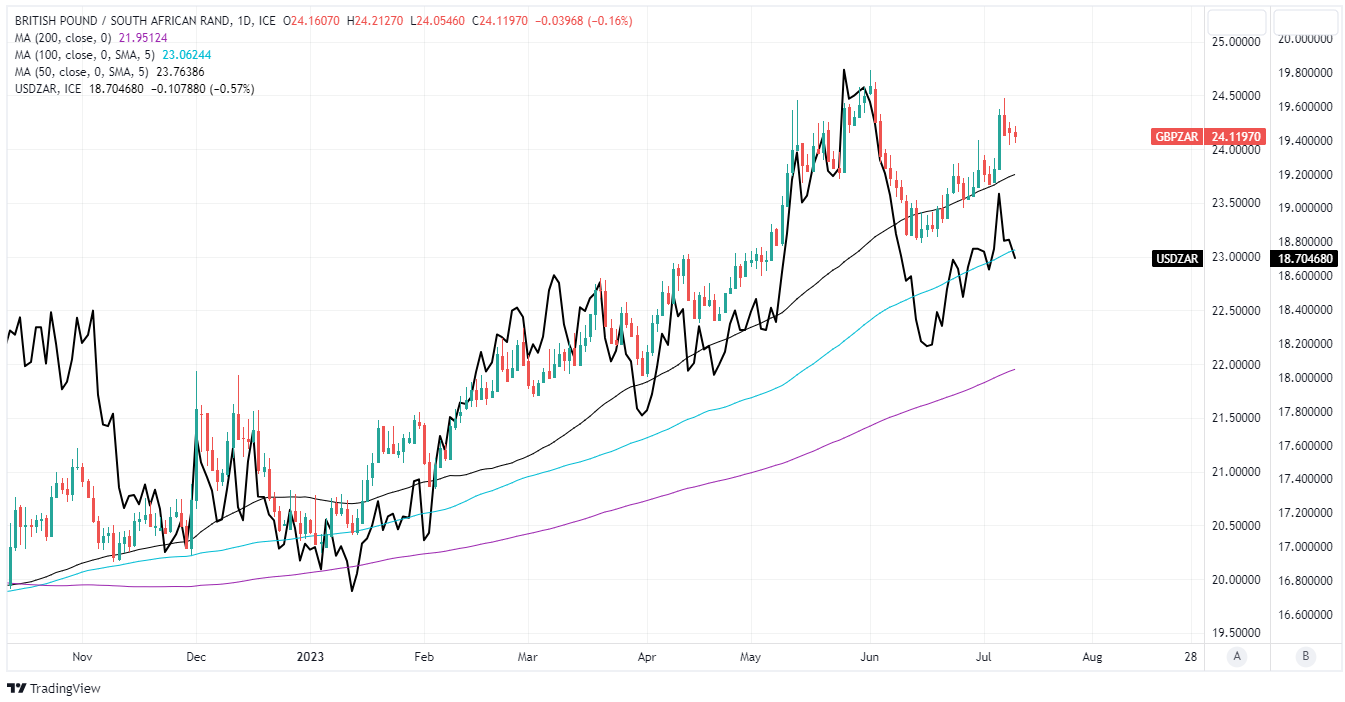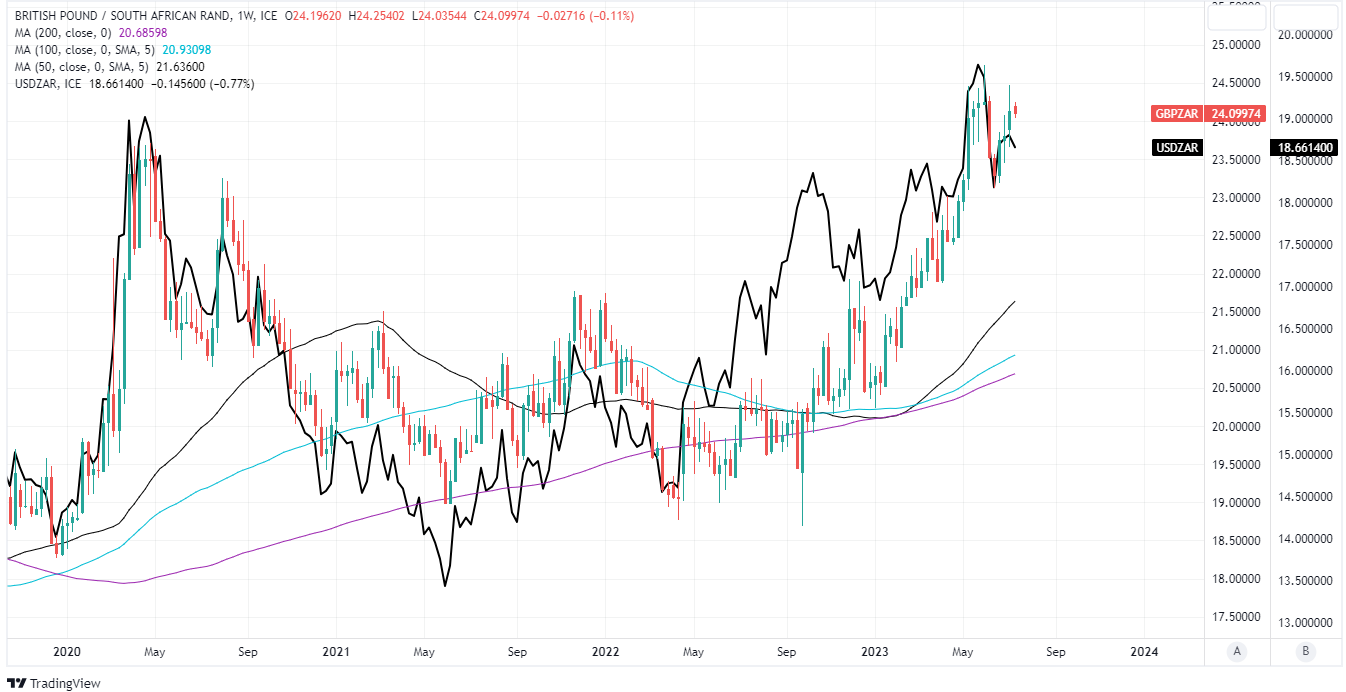Pound to South African Rand Rate Trades Valley of Rally for Kiss from Rose
"The Monetary Policy Committee is monitoring developments – in particular, those in the labour market, in wage growth and in services price inflation" - BoE Governor.

Image © Adobe Images
The Pound to South African Rand exchange rate fell early in the new week but while it could descend deeper into the valley of a now receding rally on the charts, there is also the possibility of it rebounding into the 24.50 area around midweek, where GBP/ZAR has struggled to sustain momentum several times recently.
South Africa's Rand rose widely on Tuesday when climbing against all counterparts in the G20 grouping except for the South Korean Won and Russian Rouble, all of which rallied from one-week lows against the U.S. Dollar as GBP/ZAR ebbed further from the one-month high it reached last Friday.
Gains for the Rand came alongside widespread losses for U.S. Dollar exchange rates and against a mixed backdrop for Sterling, which was boosted on Tuesday as currencies responded to the latest labour market data out in the UK while being quick to moderate in strength once the stock and bond markets opened in London.
"The vacancies-to-unemployment ratio—commonly referenced by the MPC as the best indicator of labour market tightness—declined to 0.77 in May, from 0.83 in April, and a peak of 1.05 in August 2022," says Samuel Tombs, chief UK economist at Pantheon Macroeconomics, in a review of Tuesday's data.
"Meanwhile, the negligible increase in the PAYE measure of employee numbers in June supports other indicators, such as the REC/KPMG Report on Jobs survey and the Insolvency Service’s data on redundancy notifications, in suggesting that corporate demand for labour is stagnating," he adds
Above: GBP/ZAR shown at 4-hour intervals with Fibonacci retracements of June losses indicating possible areas of technical resistance for Sterling.
South Africa's economic calendar was sparse in its offering of local data points on Tuesday as well as for the week overall but here was much in the labour market report to potentially explain the losses seen by Sterling and GBP/ZAR, including an increase in the unemployment rate for the UK.
Unemployment jumped to 4% in May and what was an upside surprise for the economist consensus, which had tipped an unchanged reading but might have overlooked the prior month's reported increase in "unemployment-related welfare claims numbers."
The latter had warned of a further uptick in the three-month unemployment rate to come, though for Sterling, financial markets and the Bank of England (BoE) it might well be Tuesday's measure of wage growth that would appear more important after the measure of regular pay continued to increase at a record rate.
"For regular pay, this equals the highest growth rate, which was also seen last month and during the coronavirus (COVID-19) pandemic period for April to June 2021," the Office for National Statistics says of the 7.2% increase in regular pay excluding bonuses over the year to the end of May.
Above; Theme tune of the week for GBP/ZAR.
Rising pay growth is exactly the kind of thing that would typically lead the Bank of England into a hawkish interest policy stance, though Pantheon's Tombs and colleagues say "signs that the labour market is loosening quickly," might actually be most likely to give the BoE cause to pause before long.
The limited decline of UK inflation rates so far and high levels of ongoing wage growth have both led financial markets to wager that Bank Rate is likely to rise significantly further from its current 5% level later this year, though communications from the BoE itself have been more reserved.
"This is a good thing in many ways. No one wishes to see unemployment higher or growth weaker. But the interaction of above-target headline inflation with labour market tightness and demand pressure in the economy has made underlying developments in goods and services price inflation more sticky than previously expected. Both price and wage increases at current rates are not consistent with the inflation target," Bank of England Governor Andrew Bailey said in a speech on Monday.
"In the face of these inflationary pressures, monetary policy has been tightened. Over the last twenty months, we have raised Bank Rate by nearly five percentage points. Some of
that tightening is still to come through the policy pipeline, and we expect underlying inflationary pressures to recede as headline inflation falls. But the Monetary Policy Committee is monitoring developments – in particular, those in the labour market, in wage growth and in services price inflation," he added.
Above: GBP/ZAR shown at daily intervals with selected moving averages indicating possible areas of technical support and shown alongside USD/ZAR.
GBP/ZAR came off worse from Tuesday's data but will remain sensitive to the ebb and flow of market expectations for BoE policy, while also likely being responsive later this week to things like the inflation figures due out in the U.S. on Wednesday and the GDP date from the UK on Thursday.
International events are the highlights of the week for the South African currency owing to the absence of domestic data but some local economists say the large scale of earlier losses in Rand exchange rates is likely to limit their downside up ahead.
This is one reason why GBP/ZAR could struggle to get beyond 24.50 over the coming days, while the risk of fresh or further losses for Sterling is another.
"The rand will remain beholden to US data releases, exhibiting high sensitivity. However, at a very depreciated rate of close to R19.00/USD, dollar small percentage moves appear exaggerated by the level of weakness it has reached since a year ago," writes Annabel Bishop, chief economist at Investec, in a Monday research briefing.
"For South Africa, rand weakness is also heavily underpinned by the weak economic outlook, and deterioration in economic growth over the past decade, which has continued into this decade under deteriorating factors of production," she adds.
Above: GBP/ZAR shown at weekly intervals with selected moving averages indicating possible areas of technical support and shown alongside USD/ZAR.



